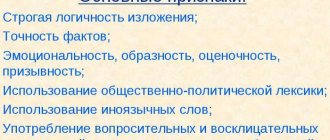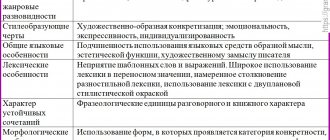Journalistic style: Freepick Who uses the journalistic style and why? People come across examples of such texts everywhere. This style is the king and god of the media, journalists and bloggers. Let's look at its features using vivid examples, which will help you create, for example, your own blog or design your Instagram page in an unusual way.
Journalistic style: scope of use, features
Speech styles are its varieties that are used for specific purposes. We encounter the journalistic style every day, since the main area of its use is journalism. Modern man lives in the information field. He is constantly in contact with various information resources:
- reads news on newspapers and on the Internet;
- gets acquainted with popular science articles in magazines and almanacs, advertising in brochures, booklets and posters;
- reads interviews, reviews and reviews;
- watches news broadcasts on television;
- listens to the speeches of politicians and cultural figures.
This style has specific features. Knowing the signs of a journalistic style, you will not only not confuse it with other communication directions, but you will also be able to apply it in writing information texts - news, reports, speeches, articles for magazines, newspapers or an online blog.
The journalistic style of speech is based on a combination of properties of several styles. It harmoniously combines scientific, artistic and official business languages. The main features of the journalistic style are that it:
Imaginative and emotional
Artistic images, poetic comparisons and descriptions create a special atmosphere for the perception of information, which is represented by the journalistic style. The text can be tragic, dramatic, lyrical, romantic, etc.
The reader’s experiences and emotions are “switched on” with the help of rhetorical appeals, questions, exclamations, and figures of silence. All these techniques are aimed at incorporating the information received into a person’s individual experience.
Evaluative
The work of a journalist: Freepick
Journalists try to present information objectively, but at the same time they still present it in a certain way. Journalism deals with the formation of points of view and public opinion. Therefore, events are not just described, but comprehensively analyzed and evaluated.
Reliable and informative
Posts on the Internet, articles in magazines, speeches must contain information that has social, cultural, and public significance. In a journalistic text, the first place is given to information, information and data about a person, society, culture, politics and other features of people’s lives.
Verified information is used in journalistic texts. A professional journalist or blogger is obliged to find reliable, verified or official sources, and to support his words, use links to documents, photos and videos.
Logical
A journalistic text consists of sequentially presented theses, which are supported by facts or examples. They must be combined logically so that the reader or listener adequately perceives the information and forms an opinion based on it.
Understandable
Journalism has a very wide audience. She appeals to people of different social groups, representatives of different professions, ages, interests, and social status.
The text of journalism must be understood by the masses. Therefore, the linguistic features of the journalistic style consist in the use of generally accepted vocabulary, simple and complex sentences, and sometimes popular journalistic cliches. Statements become colorful thanks to phraseological units, expressively colored words, colloquial and sometimes slang vocabulary, dialectisms, and the use of slang.
Lexical material, together with grammatical priorities, is determined by the author of the text. The main selection criterion is the audience. For example, an article about a zoo for children and adults will be noticeably different. Children are interested in colorful and emotional descriptions of animals and their habits, and adults, in addition to vivid images, will be interested in statistical data on the weight, height and diet of different species.
Journalistic text is an important component of our life; whether spoken or written, it forms the information space of society.
Example of journalistic style text
“What an amazing discovery! A resident of the village of Lyamkino, which is located in the northern part of Russia, came up with and invented a unique remedy that allows potato tubers to grow up to 7 kg! Scientists spent many centuries thinking about the question “how to feed a large family?”, and our compatriot found the answer!
The inventor is still in great shock from his experiment and has not yet commented. But we can definitely say that such discoveries are a big step towards eliminating hunger in many countries!”
Syntactic features or How to determine the journalistic style of speech?
In the journalistic style of speech, nouns in the genitive case are common in the role of inconsistent definition. The role of the predicate in a sentence most often goes to the verb in the form of the imperative mood and the age verb.
The authors use homogeneous members, introductory words and sentences, participial and participial phrases and complex syntactic constructions.
REFERENCE! The linguistic means of journalistic style are often represented by ready-made speech formulas that help to easily and quickly form any text.
Emotional means of expressiveness in journalistic style of speech
Publicists often use figurative means, figurative meanings of words and words with a high emotional connotation. The means of emotional expression in this case are limitless.
A journalistic text becomes similar to a literary text, but in the second the main task is to create an artistic image, whereas in journalism it is to influence the audience. The authors use epithets, comparisons, metaphors, as well as rhetorical questions and appeals.
Related posts:
- Speech styles - a brief overview of all styles Different speech styles have their own functional characteristics. There are scientific, artistic,…
- What is "War and Peace" about? Summary of the novel “War and Peace” by chapters. All answers...
- Style of artistic text - concept, features People have learned to create various texts from letters, created many styles...
- Journalistic style: classification of popular genres What are the genres of journalistic style? The genres of journalistic style are certain...
What does journalistic style mean?
Journalism is used not only in the media, but also literary works of this style reveal true information about certain events or personalities.
In literature, journalism is usually revealed by the author through his reasoning.
While newspaper journalism conveys accurate facts on certain information.
Genres of journalistic style, such as reportage, note, interview, article, essay, feuilleton and others, stand out sharply against the background of other literary genres.
Thanks to special linguistic functions, journalistic speech has two goals:
- The first goal is aimed at accurately conveying information to listeners or readers. Such information is not only accurate, but also relevant at a certain point in time.
- the second goal is an emotional impact, that is, this style of speech helps to encourage listeners or readers on an emotional level to a certain type of action.
Perhaps this is a call for a community cleanup or a simple request not to change the channel during advertising. Yes, and this is also a journalistic style of speech.
What is a journalistic style of speech?
The main goal of journalism is to provide reliable scientific facts, information about current events, and influence the audience.
The human community cannot exist without verbal communication.
We use speech patterns not only when interacting with each other, but also to convey information to people who are far away from us, both in distance and in time space.
Thus, speech is classified into various functional styles. Each style has its own characteristics. In this article we will talk about the journalistic style of speech.
This style is inherent in the written component of speech and is the official style of the media, as well as conveying important socio-political information through speeches and encouraging listeners or readers to take active action.
Like any style of writing, journalistic has its own characteristic features. Let's look at some of the most important characteristics of journalism.
How to distinguish journalistic style from artistic style?
Journalism also has such functions as communication, expression and aesthetics.
- Communicativeness implies that the author writes his text not for internal exploitation or a specific person, but for the largest number of people. It provides the opportunity for feedback, that is, a response from the addressee (discussions, letters from readers to the newspaper editor, telephone calls to the radio, etc.). Clarity, expressiveness and respect for all participants are priorities for communication.
- Expression helps the speaker express his feelings and emotions, and also reveals his personal qualities. As in a number of styles of speech, ethical standards do not allow the author to go beyond the bounds of decency. Expressing one's feelings should not be the author's main concern.
- Aesthetics implies the reliability and accuracy of information, as well as artistic description. It is not a necessary function for journalism.
Journalistic style - definition, addressee, purpose, type of communication, author
The author appears in this style as a public figure, usually a person professionally associated with this field - a journalist, politician.
– a wide range of readers and viewers of the media (in science the term “mass dispersed addressee” is sometimes used).
The purpose of journalistic style
—give information about the latest current events in the country and the world, influence the audience, and shape public opinion.
This style functions in written and oral form, manifested in monologue, dialogue and polylogue.
Type of communication – public.
Genres and functions of journalistic style
The most characteristic genres of this style are:
The media perform the following functions in society:
• informational - inform society about events and facts occurring in society;
• commentary-evaluative – provide information about events accompanied by evaluation and commentary, influence the addressee (messages, facts and comments), form people’s opinions about a particular event, fact,
• hedonic - they represent not only entertaining information, but also information that simply gives a person pleasure.
Main features of journalistic style
• combination of expression and standard.
The presence of means reflecting expressiveness in journalism is greater than in other styles. The use of expressive means is associated with the impact on the audience.
Who made money from the death of Princess Diana and how much?
The standard appears where information is repeated every day: on official visits, when announcing a weather forecast, stating the fact of a disaster, etc.;
• constant desire for novelty, which entails the appearance of a large number of neologisms:
Neologisms, on the one hand, are a powerful means of expressing expression, on the other hand, neologisms are a colossal source of the emergence of cliches. A successfully found technique, expression, word begins to be replicated, gradually losing expression and over time becoming a common expression.
“A year-long road” - a day of 35 hours, a search of 23 years, an election of a year, Slander of 5 years, a feat of a life, etc.
• simplicity and accessibility: these qualities of a journalistic style are determined by the mass nature of the media addressee and the associated requirements for the text: small sentences, the use of commonly used vocabulary and logic, clarity, emotionality, etc.
Should we fight against smokers? From July 1, new rules for the sale of cigarettes will be introduced in Russia.
• advertising: attracting the attention of the addressee, especially manifested in headlines, is one of the most characteristic stylistic features of the journalistic style:
Which country in the world is better to get sick? Treatment with fuel oil. Lethal squad. A civilized market is beneficial to everyone, etc.
• documentary - authenticity: This quality, unfortunately, is not always characteristic of today's newspaper, television and radio materials. However, many Russian journalists support the Clean Feathers journalists’ campaign, one of the requirements of which is reliability: you can write about the reality of an event if one is confirmed by information from at least three sources independent of each other.
Our presentation
Materials are published with the personal permission of the author - Ph.D. O.A. Mazneva (see “Our Library”)
Watch a bright story-based video comic about journalistic style here
Source
Morphological features
It cannot be said that the language of journalism has some monopoly on certain morphological features, however, there are so-called “morphological features” that are used in journalism many times more often than in other styles. Such “signs” include the following points.
- The language of the journalistic style is rich in additions in the genitive case (solving a problem, signing an agreement, providing a service, etc.).
- He is public-oriented and therefore avoids expressing subjective opinions. This is clearly manifested in the fact that the style is characterized by referring to verbs in the third person. Impersonal offers are no less popular.
- News and oratorical speech is characterized by the use of such a technique as synecdoche, that is, the expression of the whole by one part. For example, “Russia won the match” instead of “The Russian team/Russians won the match” or “Russian consumers are waiting for prices to go down” instead of “Russian consumers are waiting for prices to go down,” etc.
- The use of uncountable nouns in the plural (elite circles, government agencies, municipal authorities, etc.) is firmly established in journalism.
- The imperative form of the verb in journalism is responsible not so much for an order to any action, but for attracting attention (Stay with us, don’t switch, think, etc.).
- Planned events in the future are usually covered in the present tense, which is typical of the English language (a new exhibition complex opens tomorrow, recruitment of volunteers begins next month, etc.).
- In journalism, the percentage of use of derivative prepositions is very high (due to, on the basis of, taking into account, for the reason, etc.).
- Abbreviations are widely used in journalism (UN, EU, NATO, BRICS, SCO, etc.).
- This style is characterized by the use of words with such prefixes as: de-, a-, anti-, post-, inter-, inter- and others, as well as suffixes: -i(ya), -ism, -ist, -ization, - tion, etc.










